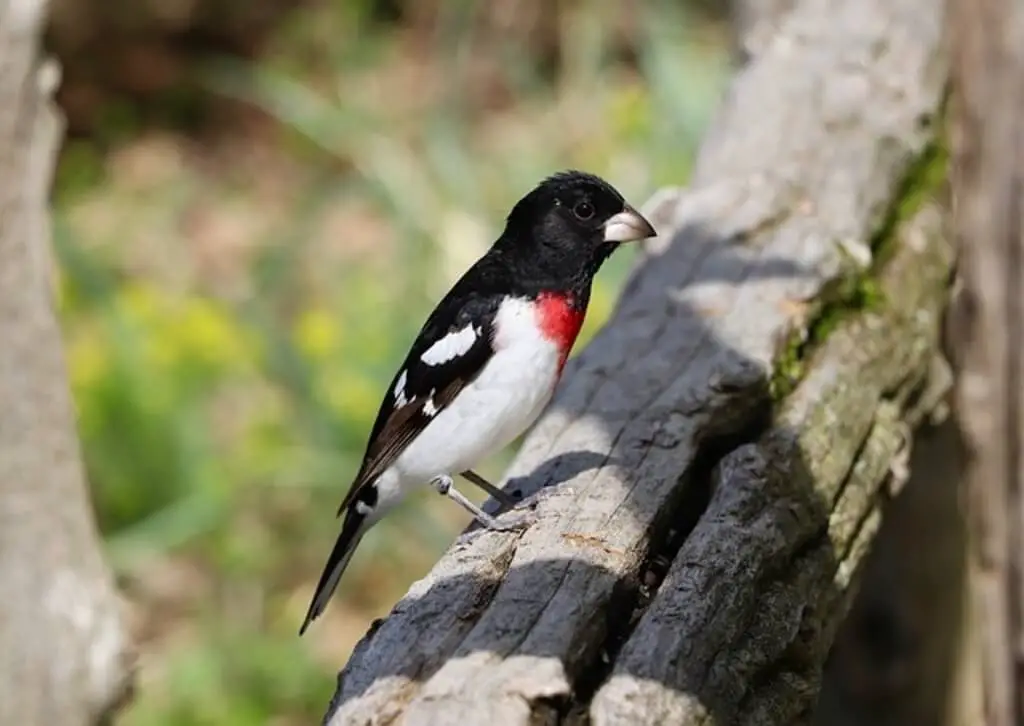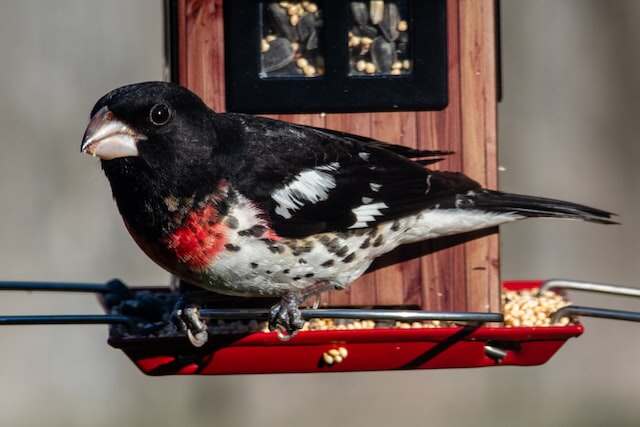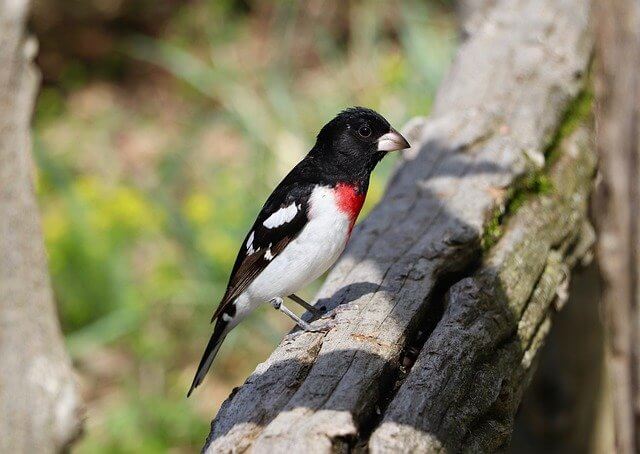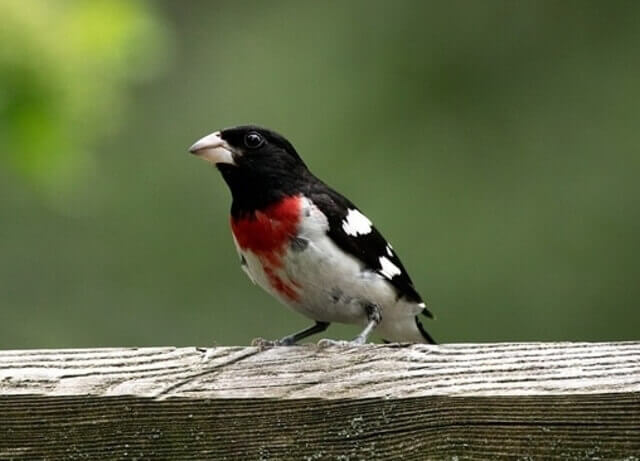Rose-breasted Grosbeaks are a beautiful and elusive species of birds known for their vibrant coloring and melodic songs. Attracting these delightful birds to your garden requires a bit of effort, but with the right approach, you can create an inviting environment that they’ll love.
In this article, we will provide expert tips on how to attract Rose-breasted Grosbeaks to your garden, including creating a bird-friendly habitat and understanding their feeding habits.
Table of Contents
- 1 Key Takeaways:
- 2 How To Attract Rose-breasted Grosbeaks?
- 3 Creating a Bird-Friendly Habitat
- 4 Bird Feeder for Rose-breasted Grosbeak
- 5 Understanding Grosbeak Feeding Habits
- 6 Attracting Wildlife to Your Yard
- 7 Birdwatching Tips for Grosbeak Enthusiasts
- 8 Bird Conservation for Rose-breasted Grosbeak
- 9 Tips for Attracting Birds to Your Garden
- 10 Transform Your Backyard into the Perfect Habitat for Rose-breasted Grosbeaks
- 11 FAQs: How To Attract Rose-breasted Grosbeak?
- 11.1 How do I attract Rose-breasted Grosbeaks to my garden?
- 11.2 What type of bird feeder should I use to attract Rose-breasted Grosbeaks?
- 11.3 Where should I place the bird feeder to attract Rose-breasted Grosbeaks?
- 11.4 What are the feeding habits of Rose-breasted Grosbeaks?
- 11.5 How can I attract other wildlife to my yard along with Rose-breasted Grosbeaks?
- 11.6 What tips can you provide for birdwatching Rose-breasted Grosbeaks?
- 11.7 How can I contribute to the conservation efforts for Rose-breasted Grosbeaks?
- 11.8 Are the tips in this guide applicable to attracting other bird species?
- 11.9 How can I transform my backyard into the perfect habitat for Rose-breasted Grosbeaks?
- 12 Author
Key Takeaways:
- Creating a bird-friendly habitat is crucial to attracting Rose-breasted Grosbeaks and other bird species to your garden
- Providing food, water, shelter, and nesting opportunities are key elements to consider when enhancing your backyard for Grosbeaks
- A well-placed bird feeder can be a fantastic attraction for Rose-breasted Grosbeaks, but it’s important to select the right type of feeder and food to offer
- Understanding Grosbeak feeding habits, including their preferred food sources and feeding techniques, can significantly increase the chances of attracting them to your yard
- Attracting a diverse ecosystem of wildlife to your garden, including Grosbeaks, requires additional measures such as providing fresh water sources and avoiding harmful pesticides
How To Attract Rose-breasted Grosbeaks?
Attracting Rose-breasted Grosbeaks to your backyard can be a rewarding experience for birdwatchers and nature enthusiasts. These colorful birds are known for their striking plumage and sweet, warbling songs.
To attract them to your yard, provide the right food such as sunflower seeds, safflower seeds, and nyjer seeds, as well as fruits like oranges, apples, and grapes. Use platform feeders or hopper feeders and offer a source of water like a bird bath or fountain.
Planting native trees and shrubs such as dogwood, serviceberry, and elderberry can also create a suitable habitat for these birds. Avoid using pesticides in your yard to create a healthy and natural environment for these birds.
By following these tips, you can create a welcoming environment for Rose-breasted Grosbeaks and enjoy their beauty and song in your backyard.
Creating a Bird-Friendly Habitat
If you want to attract Rose-breasted Grosbeaks to your backyard, it’s essential to create a bird-friendly habitat. Here are some expert tips to enhance your backyard for Grosbeaks:
Food Sources
Providing a variety of foods will attract a greater number of bird species, including Grosbeaks. Planting native fruit and nut-bearing trees, like serviceberry and oak, is a great idea to offer natural sources of food. You can also supplement their diet with sunflower seeds, safflower seeds, and suet.
Water Sources
Water is vital for birds’ survival, and providing a fresh and clean water source is essential. A bird bath, fountain, or shallow dish will do the job. Make sure to keep the water level consistent and change it frequently to prevent the growth of harmful bacteria.
Shelter and Nesting Opportunities
Birds need shelter to hide from predators and nesting opportunities to raise their young. You can add birdhouses, bird-friendly shrubs, and trees to your backyard to create suitable habitats for Grosbeaks. Make sure to keep them clean and well-maintained.
Plants and Landscaping
Consider incorporating native plants that provide food, shelter, and nesting opportunities for birds into your landscaping. Avoid using harmful pesticides that can harm the ecosystem and birds.
By following these tips and enhancing your backyard with bird-friendly features, you’ll create an irresistible haven for Rose-breasted Grosbeaks and other stunning bird species.
Bird Feeder for Rose-breasted Grosbeak
A well-placed bird feeder can be a fantastic way to attract Rose-breasted Grosbeaks to your garden. To effectively use a bird feeder, you need to select the right type of feeder, place it in an optimal location, and offer the right kind of food.
Choosing the Right Bird Feeder
When selecting a bird feeder for Grosbeaks, choose a model that is squirrel-proof and has perches that can accommodate their size and weight. A popular option is the tube feeder, which has a metal mesh to hold large seeds and a plastic or metal cover to prevent moisture from entering and spoiling the food.
Placing the Bird Feeder in the Optimal Location
Choosing a suitable location for the bird feeder is key to attracting Rose-breasted Grosbeaks. Place the feeder in a quiet area that is not too exposed to wind or sun, and where they can easily access it. Consider placing it near trees or shrubs, which provide shelter and perching opportunities for the birds.
Offering the Right Food
Rose-breasted Grosbeaks prefer black oil sunflower seeds, safflower seeds, and fruit, such as oranges and grapes. You can also offer them suet, a high-energy food that is particularly useful during the colder months. Avoid using mixed birdseed or peanuts, which can attract unwanted rodents and other pests.
Remember to clean the bird feeder regularly to prevent bacteria growth and disease transmission. Also, regularly check the feeder to ensure it is not empty, and refill it often to keep the Grosbeaks coming back.
Using a bird feeder can be a fantastic way to attract Rose-breasted Grosbeaks to your garden, providing them with a reliable source of food.
By selecting the right feeder, placing it in an optimal location, and offering the right food, you can significantly increase your chances of attracting these stunning birds to your backyard.
Understanding Grosbeak Feeding Habits
As with any bird species, understanding the feeding habits of Rose-breasted Grosbeaks is key to attracting them to your garden. These birds are primarily seed-eaters, with their diet consisting of fruits, nuts, and insects during the breeding season. During the winter months, they rely heavily on seeds.
When it comes to feeding techniques, Grosbeaks tend to forage near the ground and prefer to feed alone or in pairs. They are also known to visit bird feeders, particularly those that offer sunflower seeds or safflower seeds.
It’s important to note that feeding preferences can vary depending on the time of year. During spring and summer, Grosbeaks focus on high-protein foods, such as insects, to support their breeding activities. In the fall and winter, they switch to high-fat foods, such as nuts and seeds, to help them survive the colder temperatures.
By catering to their dietary preferences, you can significantly increase the chances of attracting Rose-breasted Grosbeaks to your garden. Make sure to provide a variety of food sources throughout the year to accommodate their changing needs.
Attracting Wildlife to Your Yard
Attracting Rose-breasted Grosbeaks to your garden involves more than just creating a suitable habitat for them. If you want to increase your chances of attracting a wide variety of wildlife, including these stunning birds, there are additional measures you can take to create a diverse ecosystem in your yard.
Incorporate Native Plants
Planting native vegetation in your yard is one of the most effective ways to attract wildlife, including Rose-breasted Grosbeaks. Native plants provide essential food and shelter for birds and other animals, making your yard an irresistible destination. Additionally, native plants require less maintenance and are more resistant to pests and disease.
Provide Fresh Water Sources
Having a reliable source of fresh water is imperative for attracting wildlife, as it provides essential hydration and bathing opportunities. Consider installing a birdbath or creating a small pond to attract a wide variety of birds and other animals. Ensure to keep the water clean and fresh, and keep it topped up during dry weather.
Avoid Pesticides
The use of pesticides can harm and even kill birds and other wildlife, so it’s crucial to avoid them. Instead, choose natural alternatives such as companion planting or pest-repelling plants. When you keep your yard free of harmful chemicals, you create a safe haven for birds and other wildlife to thrive in.
Create Nesting Opportunities
Providing nesting opportunities for wildlife in your yard is a great way to attract them and create a sustainable environment. Consider adding nesting boxes or leaving dead trees and branches in place, which can provide an ideal habitat for birds to raise their young.
- Plant native vegetation to provide essential food and shelter
- Install a birdbath or create a small pond to provide fresh water sources
- Avoid pesticides and choose natural alternatives
- Provide nesting opportunities for wildlife
By taking these measures, you can create a thriving ecosystem in your own backyard that attracts a wide variety of birds, including the elusive Rose-breasted Grosbeak. So, go ahead and transform your yard into a wildlife-friendly haven today!
Birdwatching Tips for Grosbeak Enthusiasts
If you’re a bird enthusiast looking to observe Rose-breasted Grosbeaks in their natural habitat, these expert tips will help you enhance your birdwatching experience:
Invest in High-Quality Binoculars
A pair of high-quality binoculars is an essential tool for any birdwatcher. Look for binoculars that offer clear and crisp images, have a comfortable grip, and are easy to use. A magnification of 8x to 10x is ideal for observing Grosbeaks, as it allows you to see them up close without making them feel threatened.
Learn to Identify Their Behaviors
Observing Rose-breasted Grosbeaks’ behaviors and movements can provide valuable insights into their personalities. Watch how they interact with each other, how they navigate their surroundings, and how they respond to environmental stimuli.
Recognize Their Vocalizations
Rose-breasted Grosbeaks have a rich and varied vocal repertoire. Learn to identify their songs and calls so you can locate them more easily. You can find recordings of their vocalizations online or download birding apps that provide audio clips.
Observe Them During Different Times of the Day
Rose-breasted Grosbeaks are most active in the early morning and late afternoon. By observing them during different times of the day, you can gain a more comprehensive understanding of their behavior patterns and preferences.
Be Respectful of Their Space
When birdwatching, it’s essential to respect the Grosbeaks’ space and not disturb them. Don’t approach them too closely or make sudden movements that may scare them away. If you notice them becoming agitated or stressed, back off and observe them from a distance.
By implementing these tips, you can elevate your birdwatching experience and enjoy the vibrant beauty and personality of the Rose-breasted Grosbeak in their natural habitats.
Bird Conservation for Rose-breasted Grosbeak
As avid bird enthusiasts, it is crucial to contribute to the conservation efforts for Rose-breasted Grosbeaks. These stunning birds are facing threats such as habitat loss, climate change, and pesticide use. By actively engaging in bird conservation, we can help ensure a thriving future for the Grosbeak population.
Bird conservation for Rose-breasted Grosbeak can begin in your very own backyard. Creating a bird-friendly environment, such as providing food, water, shelter, and nesting opportunities, can go a long way in promoting the birds’ well-being. Incorporating native plants and avoiding the use of harmful pesticides are other measures you can take to attract birds to your garden while supporting bird conservation.
Participating in citizen science projects is another avenue to help protect and conserve birds. There are several programs that welcome individuals to contribute observations of birds, including the Rose-breasted Grosbeak, to further scientific research. Additionally, supporting organizations dedicated to preserving bird habitats through donations or volunteer work can aid in conservation efforts.
Creating awareness about bird conservation for Rose-breasted Grosbeak is crucial in promoting their well-being. Share your knowledge and experience with friends, family, and community members. Encouraging others to take small steps in their own backyards can create a ripple effect in bird conservation efforts.
Overall, bird conservation for Rose-breasted Grosbeak plays an essential role in preserving the beauty and diversity of our ecosystems. By engaging in conservation efforts, we can help ensure a thriving future for these captivating birds and their habitats.
Tips for Attracting Birds to Your Garden
If you’re interested in attracting birds, including the stunning Rose-breasted Grosbeak, to your garden, there are a few things you can do to make your yard more inviting.
Select the Right Plants
One of the best ways to attract birds to your garden is by planting the right types of vegetation. Native plants, including trees, shrubs, and flowers, provide food and shelter for birds, including the Rose-breasted Grosbeak. Consider incorporating plants that produce fruit or seeds, such as sunflowers, coneflowers, and black-eyed Susans. These plants not only provide nourishment for birds but also add color and beauty to your yard.
Provide a Water Source
Water is essential for birds, and providing a fresh water source can be a significant attraction. Consider incorporating a bird bath or fountain in your yard. Ensure the water is clean and replenish it regularly to keep it fresh. Birds are attracted to the sound of running water, so consider incorporating a water feature that includes a waterfall or gently bubbling stream.
Offer a Variety of Foods
Offering a variety of foods can attract a diverse range of bird species, including the Rose-breasted Grosbeak. Provide seed mixtures that include sunflower seeds, safflower seeds, and millet. Consider offering suet or other fatty foods, particularly in colder months when birds need extra nourishment.
Avoid Harmful Chemicals
Avoid the use of pesticides and herbicides in your yard. These chemicals can be harmful to birds and other wildlife and can disrupt the ecological balance in your garden. Instead, consider incorporating natural pest control methods, such as companion planting and using organic fertilizers.
By incorporating these tips and techniques into your backyard design, you can create a welcoming environment for a variety of bird species, including the beautiful Rose-breasted Grosbeak.
Transform Your Backyard into the Perfect Habitat for Rose-breasted Grosbeaks
Creating an inviting environment for Rose-breasted Grosbeaks requires thoughtful planning and implementation of various bird-friendly features. By following the expert tips and techniques outlined in this guide, you can transform your backyard into the perfect habitat for these stunning birds and other fascinating wildlife. Here are some additional strategies to enhance your backyard and increase your chances of attracting Rose-breasted Grosbeaks:
Provide Fresh Water Sources
In addition to offering food and shelter, providing fresh water sources is critical to attracting a variety of wildlife to your yard. Consider adding a birdbath, fountain, or small pond that can serve as a reliable water source for Grosbeaks and other birds.
Incorporate Native Plants
Native plants provide a natural food source for birds and other wildlife in your area. Consider planting species that produce berries, fruits, and seeds that Grosbeaks enjoy, such as cherry, raspberry, and sunflower. Avoid using pesticides and herbicides that can harm birds and their food sources.
Provide Nesting Opportunities
Grosbeaks build nests in trees and shrubs, so make sure your backyard has plenty of suitable nesting opportunities. You can add nesting boxes or platforms specifically designed for Grosbeaks or other cavity-nesting birds.
Engage in Bird Conservation
Participating in bird conservation efforts is crucial for ensuring the long-term survival of Rose-breasted Grosbeaks and other bird species. You can support bird conservation by creating awareness, participating in citizen science projects, and donating to bird conservation organizations.
By implementing these additional strategies in conjunction with the expert tips provided in this guide, you can transform your backyard into a diverse and inviting habitat for Rose-breasted Grosbeaks and other fascinating wildlife. Get ready to enjoy the vibrant beauty and delightful presence of these stunning birds in your own backyard.
FAQs: How To Attract Rose-breasted Grosbeak?
How do I attract Rose-breasted Grosbeaks to my garden?
To attract Rose-breasted Grosbeaks to your garden, you can create a bird-friendly habitat by providing food, water, shelter, and nesting opportunities. Additionally, placing a well-designed bird feeder with the right type of feeder and food can help attract them.
What type of bird feeder should I use to attract Rose-breasted Grosbeaks?
Rose-breasted Grosbeaks are attracted to platform feeders and tube feeders with a tray. Make sure to offer a mix of their preferred food, such as sunflower seeds and suet, at the feeder.
Where should I place the bird feeder to attract Rose-breasted Grosbeaks?
Place the bird feeder in a quiet and safe location, preferably near trees and shrubs that can provide cover for the birds. It’s also important to keep the feeder clean and filled with fresh food to keep attracting Grosbeaks.
What are the feeding habits of Rose-breasted Grosbeaks?
Rose-breasted Grosbeaks primarily feed on insects, fruits, and seeds. They are known to forage in tree canopies and may occasionally visit bird feeders for supplemental food.
How can I attract other wildlife to my yard along with Rose-breasted Grosbeaks?
Besides creating a suitable habitat for Grosbeaks, you can attract other wildlife by providing fresh water sources like birdbaths, incorporating native plants that provide food and shelter, and avoiding harmful pesticides.
What tips can you provide for birdwatching Rose-breasted Grosbeaks?
To enhance your birdwatching experience, use binoculars to observe Grosbeaks up close, learn about their behavior and vocalizations, and try to identify their preferred feeding areas in your garden.
How can I contribute to the conservation efforts for Rose-breasted Grosbeaks?
You can contribute to bird conservation by creating awareness, participating in citizen science projects like bird counts, and supporting organizations dedicated to preserving bird habitats.
Are the tips in this guide applicable to attracting other bird species?
A: Yes, many of the tips and techniques discussed in this guide can be applied to attracting a wide range of bird species to your garden.
How can I transform my backyard into the perfect habitat for Rose-breasted Grosbeaks?
By following the expert tips and techniques outlined in this guide, such as creating a bird-friendly environment, understanding their feeding habits, and engaging in bird conservation, you can increase the chances of attracting Rose-breasted Grosbeaks to your garden.








